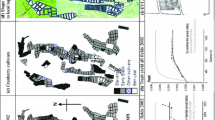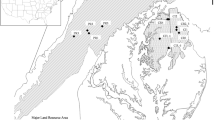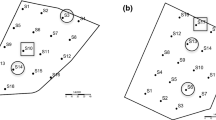Abstract
This paper proposes a methodology to improve grape yield sampling and yield estimation of the current season by using historical yield data. This approach is based on the conjoint use of (i) historical yield data all over the study field and (ii) several yield measurements collected at specific sites within the field during the current season. The proposed methodology (Optimized targeted sampling, OTS) assumes that, in viticulture, within-field yield spatial patterns are temporally stable over time as shown in previous studies (this assumption will also be verified with the data used in this study). The first principal component (PC1) of a principal component analysis (PCA) applied to the historical yield data was used to characterize the temporal behaviour of the within-field yield spatial patterns. Results showed that PC1 was always able to explain a significant percentage of the within-field yield variability across different years meaning that yield temporal stability could be assumed. PC1 scores were then used to choose the best sites to sample (targeted sampling) to estimate the yield of the current season. Yield measurements at these specific sites were used to calibrate a model relating yield values of the current season to PC1 scores. This latter model was finally used to estimate the yield of the current season at all remaining sites. This sampling method was tested on three vine fields (Vitis vinifera L.) in Chile and France with different cultivars (Chardonnay, Cabernet Sauvignon and Syrah). For each of these fields, yield data of several years (between four and seven years) were available at the within-field level. The optimised targeted sampling method (OTS) was applied to the fields under study once the temporal stability of yield patterns was validated. Results were compared to those arising from (i) a uniform random sampling method (URS) and (ii) a stratified random sampling method (SRS). Errors in yield estimates were reduced by more than 6% and 1% on average with respect to the URS and SRS methods, except when yield stable patterns were affected by specific events, i.e. early frost occurring in the season 2014 on the Chardonnay field. The findings demonstrate that the use of localized historical yield data helps to choose reliable sampling sites to improve grape yield estimation.






Similar content being viewed by others
References
Arnó, J., Martínez-Casasnovas, J. A., Uribeetxebarria, A., Escolà, A., & Rosell-Polo, J. R. (2017). Comparing efficiency of different sampling schemes to estimate yield and quality parameters in fruit orchards. In J. A. Taylor, D. Cammarano, A. Prashar, & A. Hamilton (Eds.), Proceedings of the 11th European conference on precision agriculture, advances in animal biosciences (Vol. 8(2), pp. 471–476).
Blom, P., & Tarara, J. (2009). Trellis tension monitoring improves yield estimation in vineyards. HortScience, 44, 678–685.
Bramley, R. G. V., Proffitt, A. P. B., Hinze, C. J., Pearse, B., & Hamilton, R. P. (2005). Generating benefits from precision viticulture through differential harvest. In J. V. Stafford (Ed.), Proceedings of the 5th European conference on precision agriculture (pp. 891–898). Wageningen, The Netherlands: Wageningen Academic Publishers.
Carrillo, E., Matese, A., Rousseau, J., & Tisseyre, B. (2016). Use of multi-spectral airborne imagery to improve yield sampling in viticulture. Precision Agriculture, 17(1), 74–92.
Clingeleffer, P. R., Martin, S., Krstic, M., & Dunn, G. M. (2001). Crop development, crop estimation and crop control to secure quality and production of major wine grape varieties. A national approach: final report to grape and wine research & development corporation. Grape and Wine Research & Development Corporation. Canberra, Victoria, Australia: CSIRO and NRE.
Diago, M. P., Correa, C., Millàn, B., Barreiro, P., Valero, C., & Tardaguila, J. (2012). Grapevine yield and leaf area estimation using supervised classification methodology on RGB images taken under. Sensors, 12, 16988–17006.
Dunn, G., & Martin, S. (2004). Yield prediction from digital image analysis: A technique with potential for vineyard assessments prior to harvest. Australian Journal of Grape and Wine Research, 10, 196–198.
Efron, B. (1979). Computers and the theory of statistics: Thinking the unthinkable. SIAM Review, 21(4), 460–480.
Grocholsky, B., Nuske, S., Aasted, M., Achar, S., & Bates, T. (2011). A camera and laser system for automatic vine balance assessment. Paper no. 11-11651. St Joseph, MI, USA: ASABE.
Lesch, S. (2005). Sensor-directed response surface sampling designs for characterizing spatial variation in soil properties. Computers and Electronics in Agriculture, 46(1–3), 153–179.
Martínez-Casasnovas, J. A., & Bordes, X. (2005). Viticultura de precisión: predicción de cosecha a partir de variables del cultivo e índices de vegetación (Precision viticulture: yield prediction from crop variables and vegetation indices). Revista de la Asociación Española de Teledetección, 24, 67–71.
Meyers, J. M., Sacks, G. L., van Es, H. M., & Vanden Heuvel, J. E. (2011). Improving vineyard sampling efficiency via dynamic spatially-explicit optimisation. Australian Journal of Grape and Wine Research, 17, 306–315.
Meyers, J. M., & Vanden Heuvel, J. E. (2014). Use of normalized difference vegetation index images to optimize vineyard sampling protocols. American Journal of Enology and Viticulture, 65, 250–253. https://doi.org/10.5344/ajev.2014.13103.
Miranda, C., Santesteban, L. G., Urrestarazu, J., Loidi, M., & Royo, J. B. (2018). Sampling stratification using aerial imagery to estimate fruit load in peach tree orchards. Agriculture, 8(6), 1–9.
Nuske, S., Achar, S., Bates, T., Narasimhan, S., & Singh, S. (2011). Yield estimation in vineyards by visual grape detection. In Proceedings of the 2011 IEEE/RSJ international conference on intelligent robots and systems (pp. 2352–2358).
Rabatel, G., & Guizard, C. (2007). Grape berry calibration by computer vision using elliptical model fitting. In J. V. Stafford (Ed.) Precision agriculture ‘07, proceedings of the 6th European conference on precision agriculture (pp. 581–587). Wageningen, The Netherlands: Wageningen Academic Publishers.
Reis, M. J. C. S., Morais, R., Peres, E., Pereira, C., Contente, O., & Soares, S. (2012). Automatic detection of bunches of grapes in natural environment from color images. Journal of Applied Logic, 10, 285–290.
Rousseau, J., Dupin, S., Acevedo-Opazo, C., Tisseyre, B., & Ojeda, H. (2008). L’imagerie aérienne: application à la caractérisation des potentiels viticoles et oenologiques [Airborne imagery: application to the characterization of viticultural and oenological potential]. Bulletin de l’organisation international de la vigne et du vin, 81, 507–517.
Seccia, A., Santeramo, F. G., & Nardone, G. (2016). Risk management in wine industry: A review of the literature. BIO Web of Conferences, 7, 03014. https://doi.org/10.1051/bioconf/20160703014.
Serrano, E., Roussel, S., Gontier, L., & Dufourcq, T. (2005). Estimation précoce du rendement de la vigne: corrélation entre le volume de la grappe de vitis vinifera en cours de croissance et son poids à la récolte (Early grape yield estimation: correlation between the volume of the cluster of vitis vinifera during growth and harvest weight). In H. Schultz (Ed.), Proceeding of the Groupe Européen d’Etude des Systémes de Conduite de la Vigne, Information and Technology for Sustainable Fruit and Vegetable Production (pp. 311–318).
Taylor, J. A., Sánchez, L., Sams, B., Haggerty, L., Jakubowski, R., Djafour, S., et al. (2016). Evaluation of a commercial grape yield monitor for use mid-season and at-harvest. OENO One, 50(2), 57–63.
Taylor, J. A., Tisseyre, B., Bramley, R. G. V., & Reid, A. (2005). A comparison of the spatial variability of vineyard yield in European and Australian production systems. In J. V. Stafford (Ed.), Precision agriculture’05. Proceedings of the 5th European conference on precision agriculture (pp. 907–914). Wageningen, The Netherlands: Wageningen Academic Publishers.
Tisseyre, B., Mazzoni, C., & Fonta, H. (2008). Within-field temporal stability of some parameters in viticulture: Potential toward a site specific management. Journal International des Sciences de la Vigne et du Vin, 42(1), 27–39.
Verdugo-Vásquez, N., Acevedo-Opazo, C., Valdés-Gómez, H., Ingram, B., García de Cortázar-Atauri, I., & Tisseyre, B. (2018). Temporal stability of within-field variability of total soluble solids of grapevine under semi-arid conditions: A first step towards a spatial model. OENO One, 52(1), 15–30. https://doi.org/10.20870/oeno-one.2018.52.1.1782.
Wolpert, J. A., & Vilas, E. P. (1992). Estimating vineyard yields: Introduction to a simple, two-step method. American Journal of Enology and Viticulture, 43, 384–388.
Wulfsohn, D., Aravena-Zamora, F., Potin-Téllez, C., Zamora, I., & García-Fiñana, M. (2012). Multilevel systematic sampling to estimate total fruit number for yield forecasts. Precision Agriculture, 13(2), 256–275.
Acknowledgements
This study was financially supported by National CONICYT-PCHA Doctoral Fellowship 2015 No. 21151630, Chile, Doctoral Co-tutelage Fellowship Claude Gay 2017 (France embassy) and by the experimental unite Pech Rouge, France. The authors also would like to thank K-H Schulze and all technical staff of Panguilemo Experimental Station (Talca, Chile), for their invaluable role in the good course of the experiments.
Author information
Authors and Affiliations
Corresponding author
Ethics declarations
Conflict of interest
The authors declare that they have no conflict of interest.
Additional information
Publisher's Note
Springer Nature remains neutral with regard to jurisdictional claims in published maps and institutional affiliations.
Rights and permissions
About this article
Cite this article
Araya-Alman, M., Leroux, C., Acevedo-Opazo, C. et al. A new localized sampling method to improve grape yield estimation of the current season using yield historical data. Precision Agric 20, 445–459 (2019). https://doi.org/10.1007/s11119-019-09644-y
Published:
Issue Date:
DOI: https://doi.org/10.1007/s11119-019-09644-y




